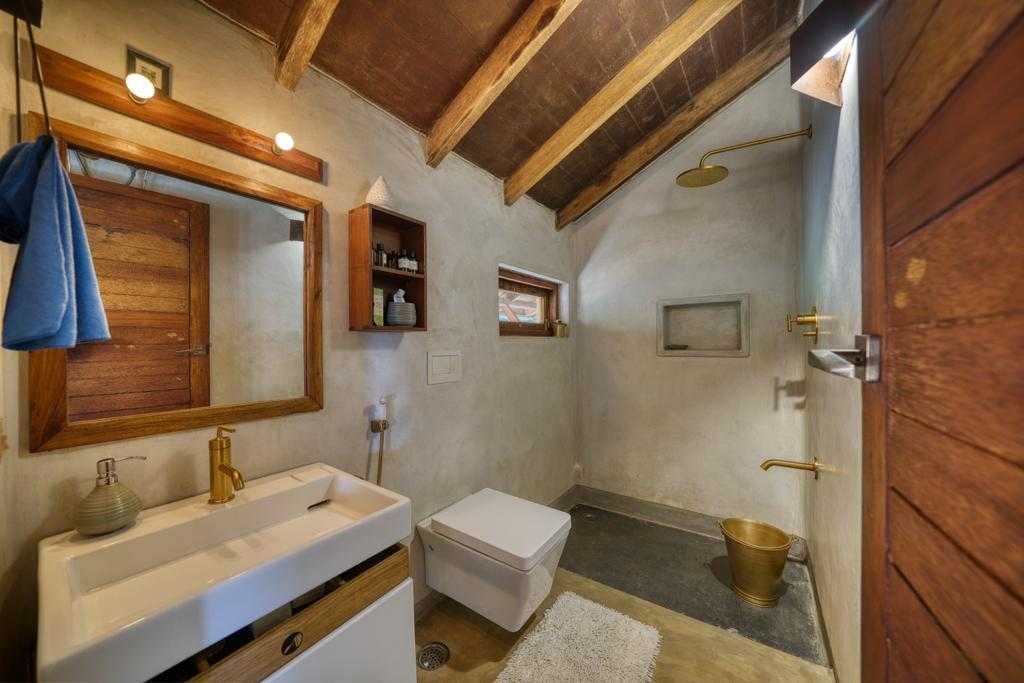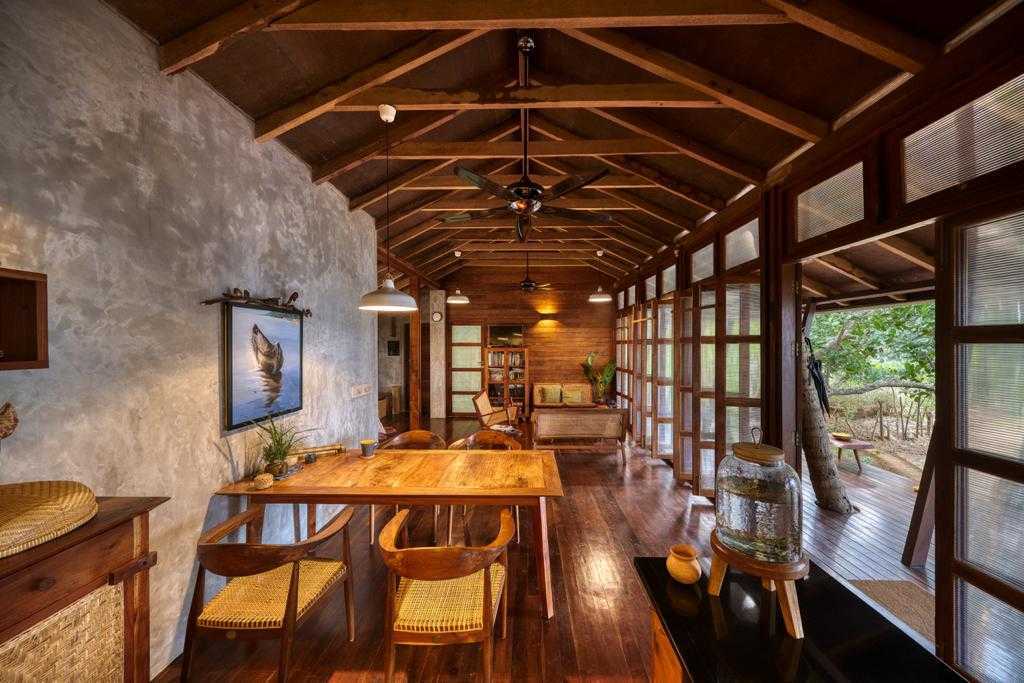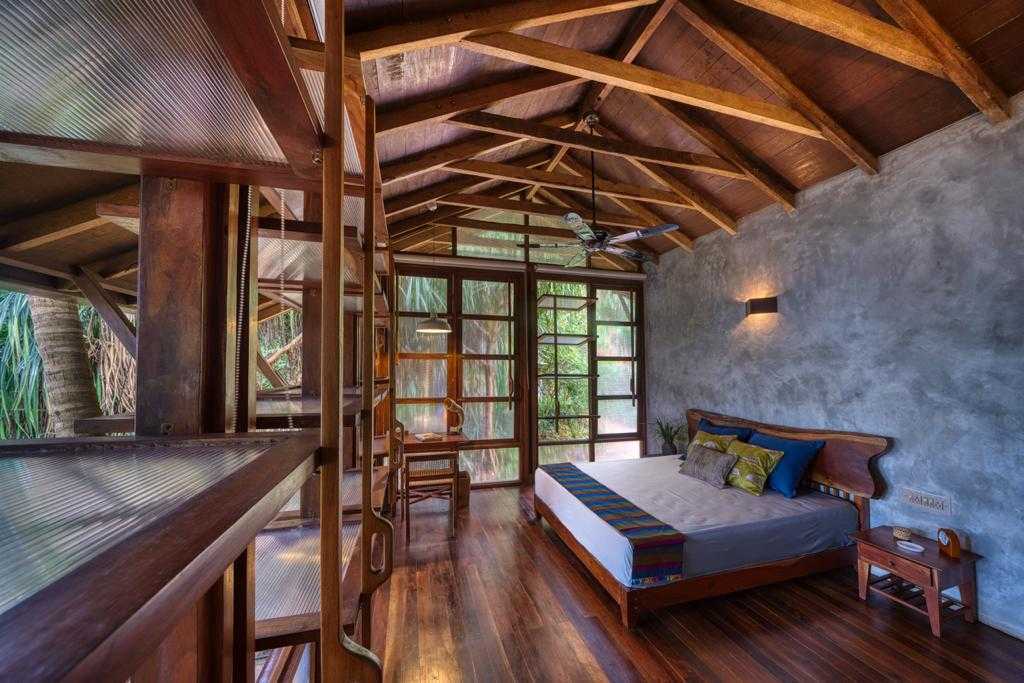Growing up in the Western Ghats, Mangal Shetty (59) and his wife Ambika developed a shared passion for nature, which continued to bring them closer. Dissatisfied with life in Bengaluru, they longed for something more.
So, in 2007, Mangal, an “entrepreneur turned ecopreneur”, says he decided to go on a quest to explore the possibility of where he could practice his values. And it was during this journey, he came across a place in coastal Karnataka nestled in the Aghanashini estuary — a space he would eventually call ‘home’.
Over the years, the sustainable project that Mangal and his wife embarked upon here is a testament to their love for nature. Their dream home, a three-bedroom plot, rises within the forests on the estuarine beach where the Aghanashini river meets the Arabian Sea. Blink twice, and you’ll almost lose sight of the home as the camouflages it.
As anyone who passes by this land would tell you, it is one with nature.

The sustainable home’s washrooms are made from laterite stone and recycled wood, Picture source: Mangal
Mangal, who was always of a business bent of mind, found himself seeking something beyond the confines of the corporate world. After discovering a potential acquisition opportunity, he sold his current company and shifted his focus to his long-awaited passion.
“I wanted to do something with nature and communities. I always believed that one can profit while creating value for the . So I bought land in this estuarine village. What drew me to this spot was the Aghanashini estuary,” he says, adding that in 2012, he started the Panchabhuta Conservation Foundation — an NGO that works with the local communities in Aghanashini to develop green enterprises in the area, while preserving the local environment in the estuary.
The Aghanashini river, originating in the Western Ghats, flows into the Arabian Sea and is said to be one of the very few virgin rivers as the flow is unobstructed. The estuary is laden with mangroves and abundant in biodiversity, attracting several species of mangroves, fishes, bivalves, oysters, crabs, birds, insects and animals. While the thick and dense vegetation impressed Mangal immediately, it also posed a problem during construction.

Lush mangroves and foliage camouflage the home from all corners, Picture source: Mangal
“My philosophy while was simple. I wanted something that would be built in nature and built by nature. I wanted a home that would be constructed without disturbing the natural ecosystem here,” he shares.
The brief that he gave architect Ajith Andagere of Andagere Architects was born out of the desire to have a space that would energise, revitalise and rejuvenate the habitat. The process of creating this “elemental” home took a total of four years and underwent several rounds of modifications before Mangal finalised it.
“ had to be inside the home as well as outside. One should be able to embrace it all and protect themselves from these elements by shutting the doors. And, you should be able to hear the birds.”

Nestled in the Aghanashini estuary, the sustainable home imbibes all forms of sustainability, Picture source: Mangal
Ask him about the size in square feet of the home and he says, “A home like this cannot be measured in square feet. It is discreet, not easily visible, and the space is distributed within the home. Nothing is confined. I love to move, so the house has been designed in a way that provides for the flow of space,” he adds.
The plot of land is almost like a jungle with trees interspersed thickly that rise through the with the roof built around them in a way to accommodate them. It entirely comprises the main house — with two ensuite bedrooms along with an attached kitchen and dining space, a guest studio, a chef’s cottage, a caretaker’s cottage, and a space for the water tank, a boiler and solar panels.
In 2017, the family was ready to move into the home.

The three bedroom house is made out of recycled wood, cane and stone and is an ode to sustainability, Picture source: Mangal
Built on stilts, the association between the is almost poetic. “Our bath place has a coconut tree in the middle as we did not want to cut down any trees. The water we bathe in feeds the tree,” says Mangal.
This tone of mindfulness of nature is echoed throughout the rest of the home. Cane, bamboo and stone are the hero materials used for construction and furnishings. Recycled acacia wood from the fallen branches and trees in the area is used for the flooring, employing only a small fraction of cement for the construction.
Laterite stones have been laid in the washrooms while terracotta has been infused into the dining space. The have been made with recycled coconut tree wood.
The home’s energy needs are fulfilled by the 4KVA solar panels, except for the freezers that depend on traditional electricity. Air conditioning isn’t used at all. The family expresses their appreciation for the home’s elemental design, which they believe contributes to its wonderful ambience, and they enjoy living in it throughout different seasons.

The home is an elemental one, with all doors and windows welcoming to the breeze and nature around, Picture source: Mangal
“The canopy of trees means it is cool in summers and comfortable during winters. In fact, the home is 2 degrees Celsius cooler than other homes on the coast,” says Mangal.
Owing to the rainfall that this side of Karnataka receives, the family has two rainwater harvesting tanks with a capacity of 20,000 litres. The 10-acre plot of land is also home to a and trees — such as coconuts, turmeric, cashew nuts, papayas, lemon grass, and more.
But ask Mangal his favourite spot in the home, and he says it is the dining space. “It is an open dining space, a gathering space that overlooks the Kirubeli Cove and the Aghanashini estuary. The visual communication is exceptional and one can feel the breeze and hear the bird songs. It’s a magical spot.”
Edited by Pranita Bhat
So, in 2007, Mangal, an “entrepreneur turned ecopreneur”, says he decided to go on a quest to explore the possibility of where he could practice his values. And it was during this journey, he came across a place in coastal Karnataka nestled in the Aghanashini estuary — a space he would eventually call ‘home’.
Over the years, the sustainable project that Mangal and his wife embarked upon here is a testament to their love for nature. Their dream home, a three-bedroom plot, rises within the forests on the estuarine beach where the Aghanashini river meets the Arabian Sea. Blink twice, and you’ll almost lose sight of the home as the camouflages it.
As anyone who passes by this land would tell you, it is one with nature.
‘I turned to nature’

The sustainable home’s washrooms are made from laterite stone and recycled wood, Picture source: Mangal
Mangal, who was always of a business bent of mind, found himself seeking something beyond the confines of the corporate world. After discovering a potential acquisition opportunity, he sold his current company and shifted his focus to his long-awaited passion.
“I wanted to do something with nature and communities. I always believed that one can profit while creating value for the . So I bought land in this estuarine village. What drew me to this spot was the Aghanashini estuary,” he says, adding that in 2012, he started the Panchabhuta Conservation Foundation — an NGO that works with the local communities in Aghanashini to develop green enterprises in the area, while preserving the local environment in the estuary.
The Aghanashini river, originating in the Western Ghats, flows into the Arabian Sea and is said to be one of the very few virgin rivers as the flow is unobstructed. The estuary is laden with mangroves and abundant in biodiversity, attracting several species of mangroves, fishes, bivalves, oysters, crabs, birds, insects and animals. While the thick and dense vegetation impressed Mangal immediately, it also posed a problem during construction.

Lush mangroves and foliage camouflage the home from all corners, Picture source: Mangal
“My philosophy while was simple. I wanted something that would be built in nature and built by nature. I wanted a home that would be constructed without disturbing the natural ecosystem here,” he shares.
The brief that he gave architect Ajith Andagere of Andagere Architects was born out of the desire to have a space that would energise, revitalise and rejuvenate the habitat. The process of creating this “elemental” home took a total of four years and underwent several rounds of modifications before Mangal finalised it.
“ had to be inside the home as well as outside. One should be able to embrace it all and protect themselves from these elements by shutting the doors. And, you should be able to hear the birds.”

Nestled in the Aghanashini estuary, the sustainable home imbibes all forms of sustainability, Picture source: Mangal
Ask him about the size in square feet of the home and he says, “A home like this cannot be measured in square feet. It is discreet, not easily visible, and the space is distributed within the home. Nothing is confined. I love to move, so the house has been designed in a way that provides for the flow of space,” he adds.
The plot of land is almost like a jungle with trees interspersed thickly that rise through the with the roof built around them in a way to accommodate them. It entirely comprises the main house — with two ensuite bedrooms along with an attached kitchen and dining space, a guest studio, a chef’s cottage, a caretaker’s cottage, and a space for the water tank, a boiler and solar panels.
In 2017, the family was ready to move into the home.

The three bedroom house is made out of recycled wood, cane and stone and is an ode to sustainability, Picture source: Mangal
A walk through the home
Built on stilts, the association between the is almost poetic. “Our bath place has a coconut tree in the middle as we did not want to cut down any trees. The water we bathe in feeds the tree,” says Mangal.
This tone of mindfulness of nature is echoed throughout the rest of the home. Cane, bamboo and stone are the hero materials used for construction and furnishings. Recycled acacia wood from the fallen branches and trees in the area is used for the flooring, employing only a small fraction of cement for the construction.
Laterite stones have been laid in the washrooms while terracotta has been infused into the dining space. The have been made with recycled coconut tree wood.
The home’s energy needs are fulfilled by the 4KVA solar panels, except for the freezers that depend on traditional electricity. Air conditioning isn’t used at all. The family expresses their appreciation for the home’s elemental design, which they believe contributes to its wonderful ambience, and they enjoy living in it throughout different seasons.

The home is an elemental one, with all doors and windows welcoming to the breeze and nature around, Picture source: Mangal
“The canopy of trees means it is cool in summers and comfortable during winters. In fact, the home is 2 degrees Celsius cooler than other homes on the coast,” says Mangal.
Owing to the rainfall that this side of Karnataka receives, the family has two rainwater harvesting tanks with a capacity of 20,000 litres. The 10-acre plot of land is also home to a and trees — such as coconuts, turmeric, cashew nuts, papayas, lemon grass, and more.
But ask Mangal his favourite spot in the home, and he says it is the dining space. “It is an open dining space, a gathering space that overlooks the Kirubeli Cove and the Aghanashini estuary. The visual communication is exceptional and one can feel the breeze and hear the bird songs. It’s a magical spot.”
Edited by Pranita Bhat
